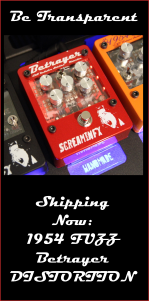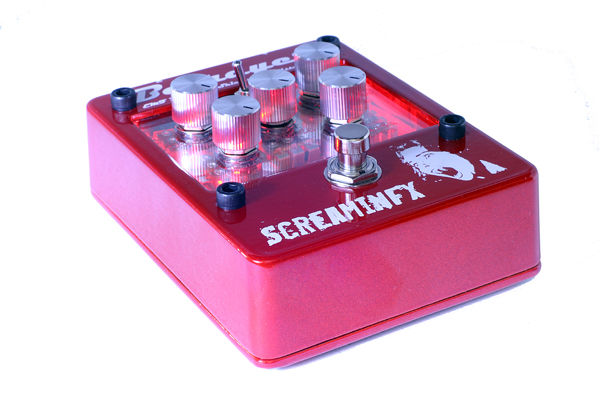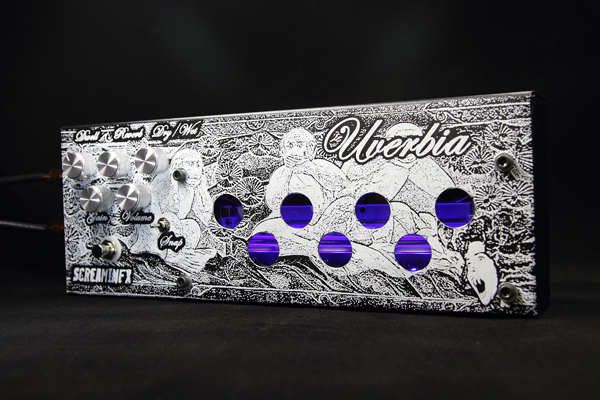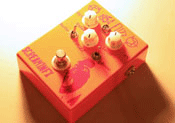In this article, I explain the difference between analog and digital in some gory detail. But first, a simple introduction.
Note: This is a technical description. It really depends who you are and what you like musically as to what sounds better to you!
The main difference between analog and digital signals is that an analog signal has no breaks (continuous) and a digital signal is made up of individual points (called discrete). Here’s a good example, your voice and your ears are both analog. When you hear something, it is continuous in time and there are no breaks. You can think of your fingers as digital, they are called digits. . . right? You can only count in 1, 2, 3 etc and it would be pretty difficult to show 3.25 with your fingers. So where is this all going to lead us? Basically, if you have a digitally produced signal, there are certain drawbacks that analog pedals will never have. These include sampled sound, pre-programmed effects and constraints on voltage levels. One reason a vintage fuzz pedal sounds so good is that the circuit reacts to all subtle nuances of your playing (small changed in voltage and current) because the actual circuit elements are analog. So in my humble opinion, analog will always be better than digital for these types of circuits. Don’t get me wrong, digital has a place, but it is in preprogrammed effects that can’t physically have the same response as an analog guitar pedal.
First Major Difference between Analog and Digital for Guitar Pedals
The infinite number or levels in an analog signal can never be captured completely with a digital pedal. Its not possible because you would need too many digital bits.
An example of an analog and digital signal is shown in Figure 1. The black analog signal is continuous and represents a sine wave. All sound is made up of sine waves and can be thought of as a repeating signal. In fact, the technical term is a rotating vector but why get too complicated. For instance, if a string vibrates (repeats) back and forth 440 times a second, then that’s an A note; as in the 2nd string of your guitar. The blue signal represents a sampled digital signal where each level is equally spaced from each other. In fact, the blue signal would be considered a 3 bit signal. Note that the levels change from 000 to 111, the first bit represents positive or negative and the last two bits represent the level.
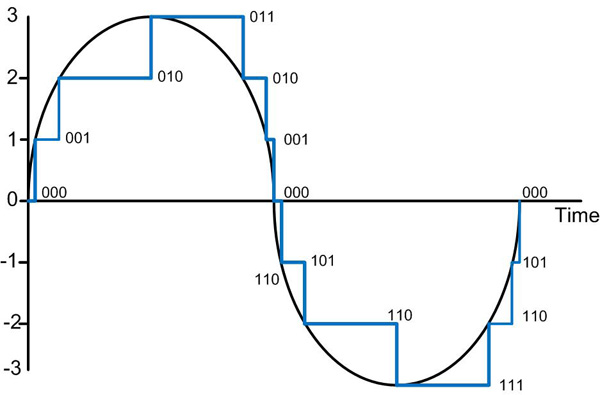
Figure 1. Analog and digital representation of a sine wave. Note that the digital samples are not evenly spaced in time but the step or magnitude is equally divided.
When you hear that something is 12 bit audio, what that means is that an analog signal is divided into 12 bits and the step size (difference between levels) is much smaller than that shown in the figure. This step size is known as resolution and you commonly use it with the term analog to digital converter (A/D) which is what is used to convert your analog guitar signal to a digital one. Side note, your cell phone also uses this to convert your voice into a signal that can be sent over the airwaves (maybe more details another time).
Second Major Difference between Analog and Digital for Guitar Pedals
Although your ear might not always detect it, a digital pedal can never sample fast enough to obtain the complete analog signal.
Have you ever heard a song that was in a format such as MP3 or iTunes that the cymbals sounded wrong? The reason is incorrect sampling and assumptions made in the encoding of the signal that result in high frequency loss and aliasing. Lets dig into this a little and learn about the details. The important point for digital guitar effects and pedals (along with all other analog or digital signals) is that different levels shown in Figure 1 are sampled evenly in time. For example, every 0.00001 seconds (10 micro seconds or 10usec), the input level at that instant is recorded and stored in memory of the pedal. A common unit is Hertz, which is samples /second or in the case of the wave, rotations per second. For our 10usec example, that means 1/10usec or 10kHz. Where this gets important is that your ear can hear vibrating waves up to about 20kHz so it is very important to sample fast enough to get the complete signal. So what would happen if a pedal samples at 10kHz, not only do you miss the high frequency sounds, you also get something nasty called aliasing.
Aliasing is what you are hearing when you listen to an MP3 and the high frequency notes such as a cymbal crash don’t sound right. Figure 2 shows an example where you can think of the black analog curve as a high frequency sound wave such as 10kHz. For simplicity, I just show 10 periods. What happens if you then sample at the same rate, for instance 10kHz? Well, when you reconstruct the signal you see that the output blue curve on the bottom is actually much slower and only half a complete sine wave in the time of ten. This means that by sampling the 10kHz guitar signal at 10kHz, you get a completely different note at 500Hz. To put it lightly, this sounds messed up and is known as aliasing.
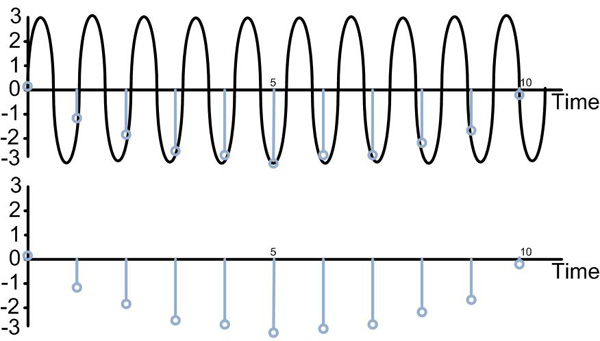
Figure 2. Example of aliasing where a 10kHz guitar signal (top black curve) is sampled at 10kHz and the resulting digital signal is only 50Hz.
Nyquest’s theorem directly deals with this problem and states that in order to accurately sample a frequency, the sampling rate must be at least twice the input frequency. So to get our 10kHz signal correct digitally, it needs to be sampled at a minimum 20kHz sampling rate and if its sampled at a higher rate, then even better. Now you know what 44kHz CD quality is; a sampling rate of 44kHz which is a little more than the 20kHz range your ear can hear.
What about those fancy digital guitar pedals and do they have aliasing problems? Of course, some of them do not sample for the full audio range. The reason is that your guitar, also your voice to a degree, contains a lot of its sound in frequencies less than 5kHz. Think about the A string (2cd string), 440Hz; if you go up an octave 880Hz, then another 1760Hz, then another 3520Hz on your guitar, you are at the 17th fret of the high E string. Kind of interesting, as you go up 12 frets, you half the length of your string and double the frequency.
Why can’t you get away with only sampling at 5kHz then for your guitar? It turns out that not only do you have the note, for instance 440Hz, you also have what are known as harmonics, or different frequencies mixed in there. The harmonics are what make up the sounds of your guitar and depend on everything that makes up your guitar: the wood type, the strings, how new the strings are, solid or hollow body and the list goes on and on. In fact, how your fingers connect with the fret board also changes this… The harmonics are mainly higher in frequency than the original note, so if you miss out on the higher frequencies, you are losing part of the sound. Therefore, you must sample higher than 5kHz and the best is at least 44kHz to get CD quality sound, or the full range of your hearing ability.
Third Major Difference between Analog and Digital for Guitar Pedals
The effect that you hear is programmed and is always the same.
When you play the guitar, as the string vibrates and essentially a magnetic wave is "picked up" by the pickups and transformed into a voltage signal. This signal is then transmitted down your guitar cable and is a fully analog signal. Once it reaches the input of your pedal, the voltage wave enters the effect and the sound is changed based on the circuit. Subtle differences, such as variations in transistors and other components will change the sound. For instance, Fuzz Face circuits need specific transistor properties to sound their best – for them the gain of each transistor is very important. Additionally, effects such as heating up of the transistors also change their properties and how the device sounds.
What a digital guitar pedal circuit does is use a program which is stored in the pedal and processes the sampled sound from the input of the pedal. Instead of the infinite variations seen in all the circuit elements of a pedal (resistors, capacitors, transistors), the program is always the same. This program must take into account all the variations to sound authentic. Each pedal will produce its own subtle harmonics which change based on how hard you play, your type of pickup and even your guitar cords you use to plug in. Ideally you don’t want your guitar cord to change the sound so read up on it in our buffer article! So, in an analog guitar pedal, you have an infinite number of variations and its not possible to completely model them all. Some digital pedals, such as a POD, do a great job of modeling different amps and pedals. But ask yourself, would you rather plug into a POD or a vintage Marshal amp. The POD has its place, but I’ll take the analog amp anytime.
Conclusion
Because the signal from your guitar is analog and a true analog pedal will perform much differently than a digital clone, my choice is always analog over digital. I’ll admit that I plug into my POD now and then, but I’ll never take a digital only pedal board on stage. To me, the digital sampling along with preprogrammed effects just isn’t the same. Custom analog pedals, tuned and crafted so that each circuit component works together, have infinitely more room for tone and playing variations.

